Business Strategy Analysis: Kellogg's Competitive Environment Report
VerifiedAdded on 2023/01/19
|10
|2991
|58
Report
AI Summary
This report provides a comprehensive analysis of Kellogg's business strategy. It begins with an introduction to business strategy and its importance, followed by an analysis of Kellogg's external environment using the PESTLE framework, examining political, economic, social, technological, legal, and environmental factors. The report then delves into the internal environment, utilizing SWOT analysis to identify strengths, weaknesses, opportunities, and threats, and VRIO analysis to assess resources. Porter's Five Forces model is applied to understand the competitive landscape, including the threat of new entrants, bargaining power of suppliers and buyers, threat of substitutes, and industry rivalry. Finally, the report discusses the application of various concepts and theories to formulate a strategic plan for Kellogg's, providing an overview of the company's operations and market position.
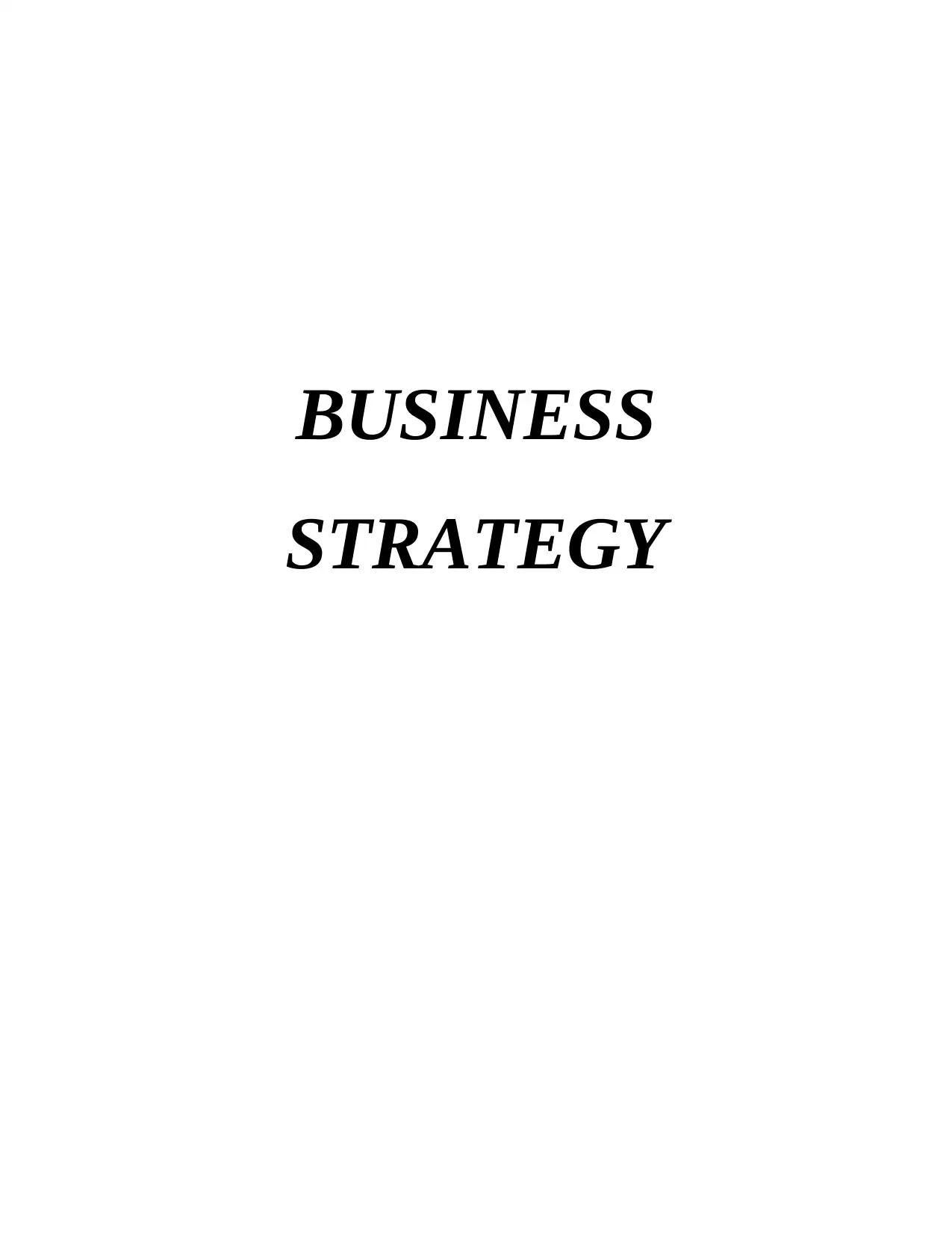
BUSINESS
STRATEGY
STRATEGY
Paraphrase This Document
Need a fresh take? Get an instant paraphrase of this document with our AI Paraphraser

Table of Contents
INTRODUCTION...........................................................................................................................3
TASK 1............................................................................................................................................3
P1. Analyse the impact of external environment on an organisation..........................................3
TASK 2............................................................................................................................................5
P2. Identify the internal environment and capability of an organization....................................5
TASK 3............................................................................................................................................7
P3. Application of Porter's Five Forces in Kellogg's..................................................................7
TASK 4............................................................................................................................................8
P4. Application of various Concepts and Theories to make Strategic plan for Organisation.....8
CONCLUSION................................................................................................................................9
REFERENCES..............................................................................................................................10
INTRODUCTION...........................................................................................................................3
TASK 1............................................................................................................................................3
P1. Analyse the impact of external environment on an organisation..........................................3
TASK 2............................................................................................................................................5
P2. Identify the internal environment and capability of an organization....................................5
TASK 3............................................................................................................................................7
P3. Application of Porter's Five Forces in Kellogg's..................................................................7
TASK 4............................................................................................................................................8
P4. Application of various Concepts and Theories to make Strategic plan for Organisation.....8
CONCLUSION................................................................................................................................9
REFERENCES..............................................................................................................................10
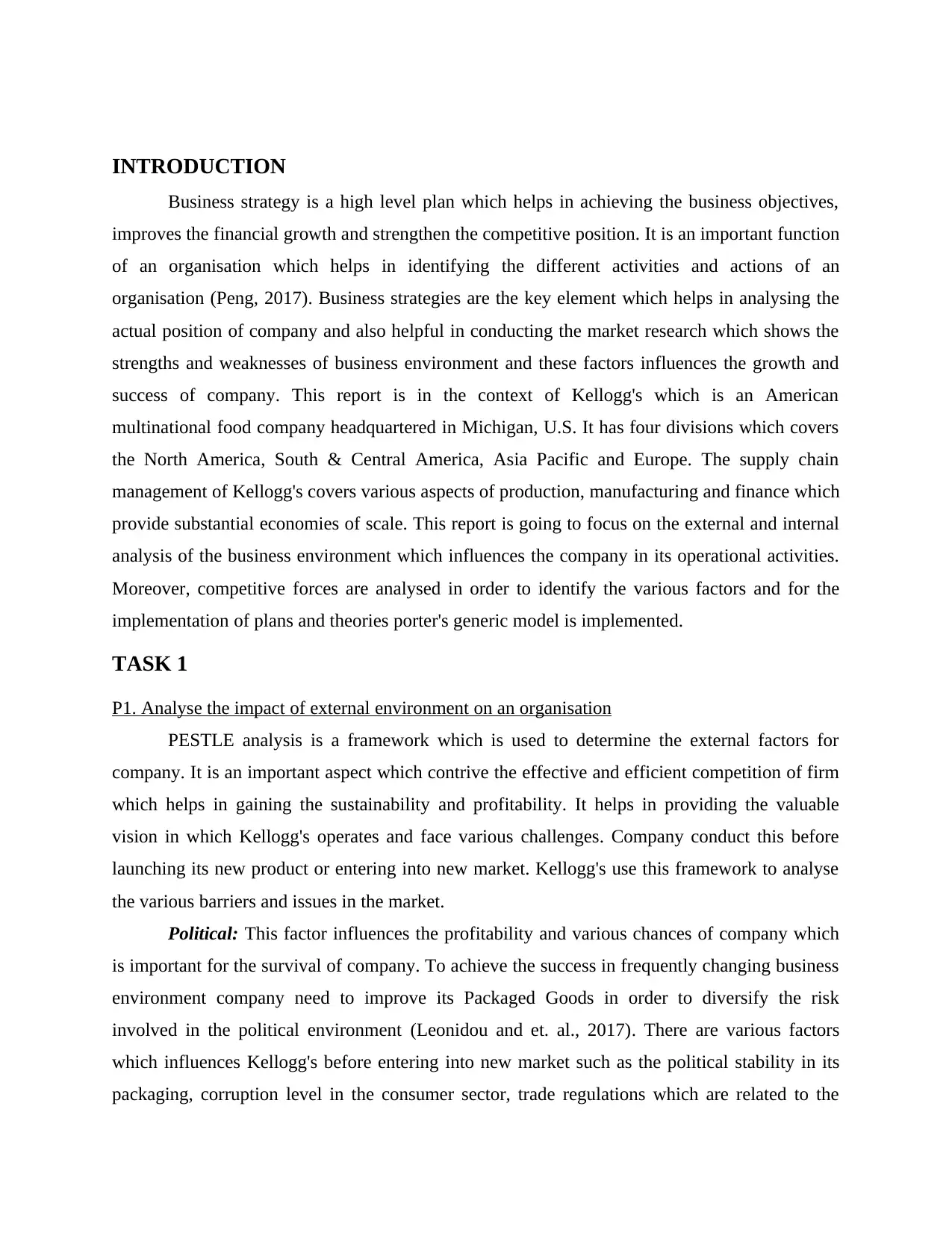
INTRODUCTION
Business strategy is a high level plan which helps in achieving the business objectives,
improves the financial growth and strengthen the competitive position. It is an important function
of an organisation which helps in identifying the different activities and actions of an
organisation (Peng, 2017). Business strategies are the key element which helps in analysing the
actual position of company and also helpful in conducting the market research which shows the
strengths and weaknesses of business environment and these factors influences the growth and
success of company. This report is in the context of Kellogg's which is an American
multinational food company headquartered in Michigan, U.S. It has four divisions which covers
the North America, South & Central America, Asia Pacific and Europe. The supply chain
management of Kellogg's covers various aspects of production, manufacturing and finance which
provide substantial economies of scale. This report is going to focus on the external and internal
analysis of the business environment which influences the company in its operational activities.
Moreover, competitive forces are analysed in order to identify the various factors and for the
implementation of plans and theories porter's generic model is implemented.
TASK 1
P1. Analyse the impact of external environment on an organisation
PESTLE analysis is a framework which is used to determine the external factors for
company. It is an important aspect which contrive the effective and efficient competition of firm
which helps in gaining the sustainability and profitability. It helps in providing the valuable
vision in which Kellogg's operates and face various challenges. Company conduct this before
launching its new product or entering into new market. Kellogg's use this framework to analyse
the various barriers and issues in the market.
Political: This factor influences the profitability and various chances of company which
is important for the survival of company. To achieve the success in frequently changing business
environment company need to improve its Packaged Goods in order to diversify the risk
involved in the political environment (Leonidou and et. al., 2017). There are various factors
which influences Kellogg's before entering into new market such as the political stability in its
packaging, corruption level in the consumer sector, trade regulations which are related to the
Business strategy is a high level plan which helps in achieving the business objectives,
improves the financial growth and strengthen the competitive position. It is an important function
of an organisation which helps in identifying the different activities and actions of an
organisation (Peng, 2017). Business strategies are the key element which helps in analysing the
actual position of company and also helpful in conducting the market research which shows the
strengths and weaknesses of business environment and these factors influences the growth and
success of company. This report is in the context of Kellogg's which is an American
multinational food company headquartered in Michigan, U.S. It has four divisions which covers
the North America, South & Central America, Asia Pacific and Europe. The supply chain
management of Kellogg's covers various aspects of production, manufacturing and finance which
provide substantial economies of scale. This report is going to focus on the external and internal
analysis of the business environment which influences the company in its operational activities.
Moreover, competitive forces are analysed in order to identify the various factors and for the
implementation of plans and theories porter's generic model is implemented.
TASK 1
P1. Analyse the impact of external environment on an organisation
PESTLE analysis is a framework which is used to determine the external factors for
company. It is an important aspect which contrive the effective and efficient competition of firm
which helps in gaining the sustainability and profitability. It helps in providing the valuable
vision in which Kellogg's operates and face various challenges. Company conduct this before
launching its new product or entering into new market. Kellogg's use this framework to analyse
the various barriers and issues in the market.
Political: This factor influences the profitability and various chances of company which
is important for the survival of company. To achieve the success in frequently changing business
environment company need to improve its Packaged Goods in order to diversify the risk
involved in the political environment (Leonidou and et. al., 2017). There are various factors
which influences Kellogg's before entering into new market such as the political stability in its
packaging, corruption level in the consumer sector, trade regulations which are related to the
⊘ This is a preview!⊘
Do you want full access?
Subscribe today to unlock all pages.

Trusted by 1+ million students worldwide

consumer good and many more. This factor impact the company in a positive way like the high
level of taxation of company would increase its profitability and company also offer low wages
to its labour which leads to high profits for company.
Economical: These factors include the foreign exchange, interest rate, GDP and current
situation of economy. In the context of Kellogg's, it consider various factors such as type of
economic system, government intervention etc. At the time of recession, the demand of
customers generally slows down but Kellogg's does not get affect much because it is very
popular in the UK for breakfast and its strong GDP emerges the market.
Social: These factors directly reflect the society and its behaviour and encompasses the
culture, attitude, values and many more. These factors are not only important for the operations
but also for the marketing of company (Moseley, 2017). The citizens of UK are more health
conscious which increases the popularity for Kellogg's and it increases the demand of it because
people of UK prefer cereals in their breakfast as it is healthy for them.
Technological: This factor frequently impacts the price structure of an industry at a very
short time and to overcome from this organisations constantly make innovative actions in order
to increase its profitability. Kellogg's adopt new technology which put positive impact as it
become popular in the industry through its questions as it is essential to monitor the behaviour of
customers and helps in frequently growing against its competitors and developing its mobile app
for the collaboration of sale.
Legal: It includes the various legal laws and regulations in which company need to
regulate and majorly it also consider the government bodies in it. This factor put negative impact
as it does not strictly consider data protection act for its ideas and patents which helps in
protecting its information and as a result its information gets stole and company lose it
competitive position or a chance for it success and growth.
Environmental: It includes the environmental protection laws and norms which is related
to the climate conditions, weather and target the pressure groups. The factors which impacts
Kellogg's include the weather conditions of UK impacts the company in order to manage its
transportation, resources and its finished product and it impacts the delivery system of final
product as it is unstable in monsoon.
level of taxation of company would increase its profitability and company also offer low wages
to its labour which leads to high profits for company.
Economical: These factors include the foreign exchange, interest rate, GDP and current
situation of economy. In the context of Kellogg's, it consider various factors such as type of
economic system, government intervention etc. At the time of recession, the demand of
customers generally slows down but Kellogg's does not get affect much because it is very
popular in the UK for breakfast and its strong GDP emerges the market.
Social: These factors directly reflect the society and its behaviour and encompasses the
culture, attitude, values and many more. These factors are not only important for the operations
but also for the marketing of company (Moseley, 2017). The citizens of UK are more health
conscious which increases the popularity for Kellogg's and it increases the demand of it because
people of UK prefer cereals in their breakfast as it is healthy for them.
Technological: This factor frequently impacts the price structure of an industry at a very
short time and to overcome from this organisations constantly make innovative actions in order
to increase its profitability. Kellogg's adopt new technology which put positive impact as it
become popular in the industry through its questions as it is essential to monitor the behaviour of
customers and helps in frequently growing against its competitors and developing its mobile app
for the collaboration of sale.
Legal: It includes the various legal laws and regulations in which company need to
regulate and majorly it also consider the government bodies in it. This factor put negative impact
as it does not strictly consider data protection act for its ideas and patents which helps in
protecting its information and as a result its information gets stole and company lose it
competitive position or a chance for it success and growth.
Environmental: It includes the environmental protection laws and norms which is related
to the climate conditions, weather and target the pressure groups. The factors which impacts
Kellogg's include the weather conditions of UK impacts the company in order to manage its
transportation, resources and its finished product and it impacts the delivery system of final
product as it is unstable in monsoon.
Paraphrase This Document
Need a fresh take? Get an instant paraphrase of this document with our AI Paraphraser
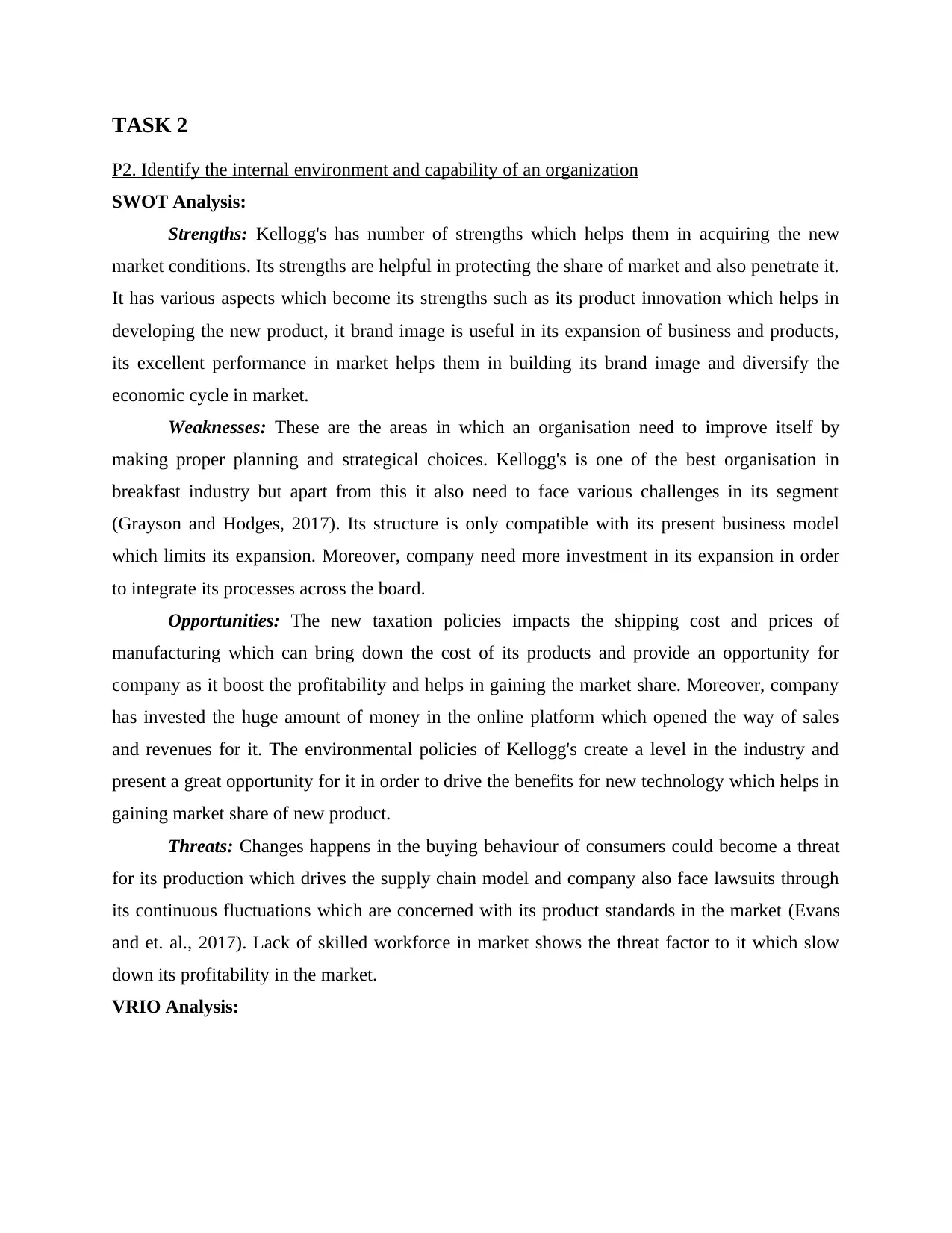
TASK 2
P2. Identify the internal environment and capability of an organization
SWOT Analysis:
Strengths: Kellogg's has number of strengths which helps them in acquiring the new
market conditions. Its strengths are helpful in protecting the share of market and also penetrate it.
It has various aspects which become its strengths such as its product innovation which helps in
developing the new product, it brand image is useful in its expansion of business and products,
its excellent performance in market helps them in building its brand image and diversify the
economic cycle in market.
Weaknesses: These are the areas in which an organisation need to improve itself by
making proper planning and strategical choices. Kellogg's is one of the best organisation in
breakfast industry but apart from this it also need to face various challenges in its segment
(Grayson and Hodges, 2017). Its structure is only compatible with its present business model
which limits its expansion. Moreover, company need more investment in its expansion in order
to integrate its processes across the board.
Opportunities: The new taxation policies impacts the shipping cost and prices of
manufacturing which can bring down the cost of its products and provide an opportunity for
company as it boost the profitability and helps in gaining the market share. Moreover, company
has invested the huge amount of money in the online platform which opened the way of sales
and revenues for it. The environmental policies of Kellogg's create a level in the industry and
present a great opportunity for it in order to drive the benefits for new technology which helps in
gaining market share of new product.
Threats: Changes happens in the buying behaviour of consumers could become a threat
for its production which drives the supply chain model and company also face lawsuits through
its continuous fluctuations which are concerned with its product standards in the market (Evans
and et. al., 2017). Lack of skilled workforce in market shows the threat factor to it which slow
down its profitability in the market.
VRIO Analysis:
P2. Identify the internal environment and capability of an organization
SWOT Analysis:
Strengths: Kellogg's has number of strengths which helps them in acquiring the new
market conditions. Its strengths are helpful in protecting the share of market and also penetrate it.
It has various aspects which become its strengths such as its product innovation which helps in
developing the new product, it brand image is useful in its expansion of business and products,
its excellent performance in market helps them in building its brand image and diversify the
economic cycle in market.
Weaknesses: These are the areas in which an organisation need to improve itself by
making proper planning and strategical choices. Kellogg's is one of the best organisation in
breakfast industry but apart from this it also need to face various challenges in its segment
(Grayson and Hodges, 2017). Its structure is only compatible with its present business model
which limits its expansion. Moreover, company need more investment in its expansion in order
to integrate its processes across the board.
Opportunities: The new taxation policies impacts the shipping cost and prices of
manufacturing which can bring down the cost of its products and provide an opportunity for
company as it boost the profitability and helps in gaining the market share. Moreover, company
has invested the huge amount of money in the online platform which opened the way of sales
and revenues for it. The environmental policies of Kellogg's create a level in the industry and
present a great opportunity for it in order to drive the benefits for new technology which helps in
gaining market share of new product.
Threats: Changes happens in the buying behaviour of consumers could become a threat
for its production which drives the supply chain model and company also face lawsuits through
its continuous fluctuations which are concerned with its product standards in the market (Evans
and et. al., 2017). Lack of skilled workforce in market shows the threat factor to it which slow
down its profitability in the market.
VRIO Analysis:

Resources Valuable Rare Imitable Organised
Brand image Brand image - - -
Finance Finance Finance - -
Technology Technology Technology Technology -
HR HR HR HR HR
Valuable: Brand image: It is valuable because the name, growth, success, customers and sales
depends on its reputation. Finance: It is valuable because it helps in investing in the future opportunities for
company which helps it in dealing with the threats. Technology: It is important for the company because every organisation has its own
technical advantages and for them it is valuable as it helps them in achieving
sustainability. HR: It is valuable because it represents the capabilities and talent of its workforce which
helps in increasing the productivity of an organisation.
Rare: Finance: It is analysed that the financial resources of Kellogg's is rare because very few
organisations know how to manage them. Technology: It is rare because every company has it own technological equipments
which are not copied by any other and not available in the market easily. HR: The workforce of an organisation is rare because company need to retain their
employees and for this they can do anything in the best possible manner.
Imitable: Technology: It cannot be imitated or copied because it is rare and every organisation has
its separate technology with their trademark and copyright. HR: The workforce of company is rare because of their talent and it cannot be imitate
and for this companies need to retain them and do best possible things for them.
Organised:
Brand image Brand image - - -
Finance Finance Finance - -
Technology Technology Technology Technology -
HR HR HR HR HR
Valuable: Brand image: It is valuable because the name, growth, success, customers and sales
depends on its reputation. Finance: It is valuable because it helps in investing in the future opportunities for
company which helps it in dealing with the threats. Technology: It is important for the company because every organisation has its own
technical advantages and for them it is valuable as it helps them in achieving
sustainability. HR: It is valuable because it represents the capabilities and talent of its workforce which
helps in increasing the productivity of an organisation.
Rare: Finance: It is analysed that the financial resources of Kellogg's is rare because very few
organisations know how to manage them. Technology: It is rare because every company has it own technological equipments
which are not copied by any other and not available in the market easily. HR: The workforce of an organisation is rare because company need to retain their
employees and for this they can do anything in the best possible manner.
Imitable: Technology: It cannot be imitated or copied because it is rare and every organisation has
its separate technology with their trademark and copyright. HR: The workforce of company is rare because of their talent and it cannot be imitate
and for this companies need to retain them and do best possible things for them.
Organised:
⊘ This is a preview!⊘
Do you want full access?
Subscribe today to unlock all pages.

Trusted by 1+ million students worldwide
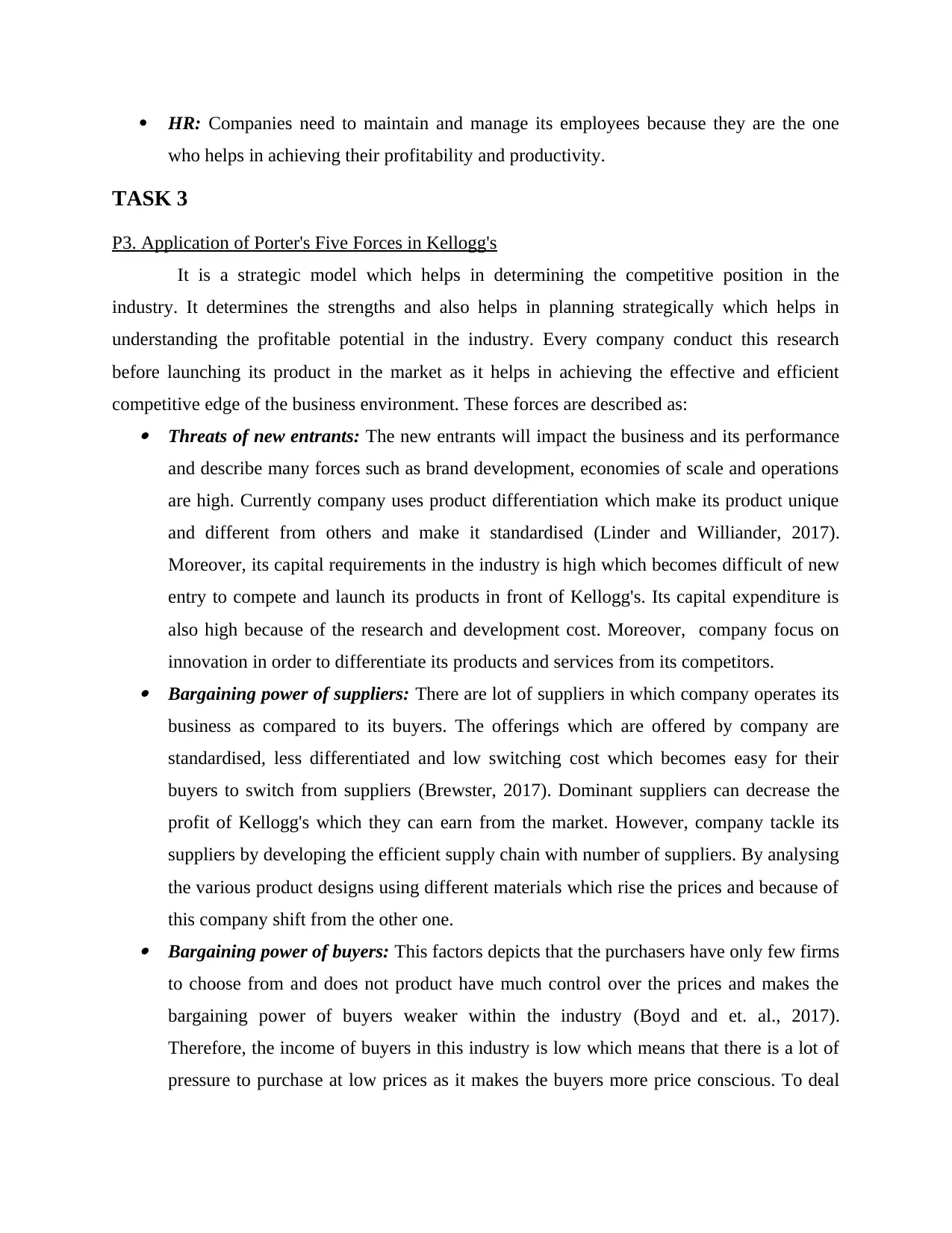
HR: Companies need to maintain and manage its employees because they are the one
who helps in achieving their profitability and productivity.
TASK 3
P3. Application of Porter's Five Forces in Kellogg's
It is a strategic model which helps in determining the competitive position in the
industry. It determines the strengths and also helps in planning strategically which helps in
understanding the profitable potential in the industry. Every company conduct this research
before launching its product in the market as it helps in achieving the effective and efficient
competitive edge of the business environment. These forces are described as: Threats of new entrants: The new entrants will impact the business and its performance
and describe many forces such as brand development, economies of scale and operations
are high. Currently company uses product differentiation which make its product unique
and different from others and make it standardised (Linder and Williander, 2017).
Moreover, its capital requirements in the industry is high which becomes difficult of new
entry to compete and launch its products in front of Kellogg's. Its capital expenditure is
also high because of the research and development cost. Moreover, company focus on
innovation in order to differentiate its products and services from its competitors. Bargaining power of suppliers: There are lot of suppliers in which company operates its
business as compared to its buyers. The offerings which are offered by company are
standardised, less differentiated and low switching cost which becomes easy for their
buyers to switch from suppliers (Brewster, 2017). Dominant suppliers can decrease the
profit of Kellogg's which they can earn from the market. However, company tackle its
suppliers by developing the efficient supply chain with number of suppliers. By analysing
the various product designs using different materials which rise the prices and because of
this company shift from the other one. Bargaining power of buyers: This factors depicts that the purchasers have only few firms
to choose from and does not product have much control over the prices and makes the
bargaining power of buyers weaker within the industry (Boyd and et. al., 2017).
Therefore, the income of buyers in this industry is low which means that there is a lot of
pressure to purchase at low prices as it makes the buyers more price conscious. To deal
who helps in achieving their profitability and productivity.
TASK 3
P3. Application of Porter's Five Forces in Kellogg's
It is a strategic model which helps in determining the competitive position in the
industry. It determines the strengths and also helps in planning strategically which helps in
understanding the profitable potential in the industry. Every company conduct this research
before launching its product in the market as it helps in achieving the effective and efficient
competitive edge of the business environment. These forces are described as: Threats of new entrants: The new entrants will impact the business and its performance
and describe many forces such as brand development, economies of scale and operations
are high. Currently company uses product differentiation which make its product unique
and different from others and make it standardised (Linder and Williander, 2017).
Moreover, its capital requirements in the industry is high which becomes difficult of new
entry to compete and launch its products in front of Kellogg's. Its capital expenditure is
also high because of the research and development cost. Moreover, company focus on
innovation in order to differentiate its products and services from its competitors. Bargaining power of suppliers: There are lot of suppliers in which company operates its
business as compared to its buyers. The offerings which are offered by company are
standardised, less differentiated and low switching cost which becomes easy for their
buyers to switch from suppliers (Brewster, 2017). Dominant suppliers can decrease the
profit of Kellogg's which they can earn from the market. However, company tackle its
suppliers by developing the efficient supply chain with number of suppliers. By analysing
the various product designs using different materials which rise the prices and because of
this company shift from the other one. Bargaining power of buyers: This factors depicts that the purchasers have only few firms
to choose from and does not product have much control over the prices and makes the
bargaining power of buyers weaker within the industry (Boyd and et. al., 2017).
Therefore, the income of buyers in this industry is low which means that there is a lot of
pressure to purchase at low prices as it makes the buyers more price conscious. To deal
Paraphrase This Document
Need a fresh take? Get an instant paraphrase of this document with our AI Paraphraser
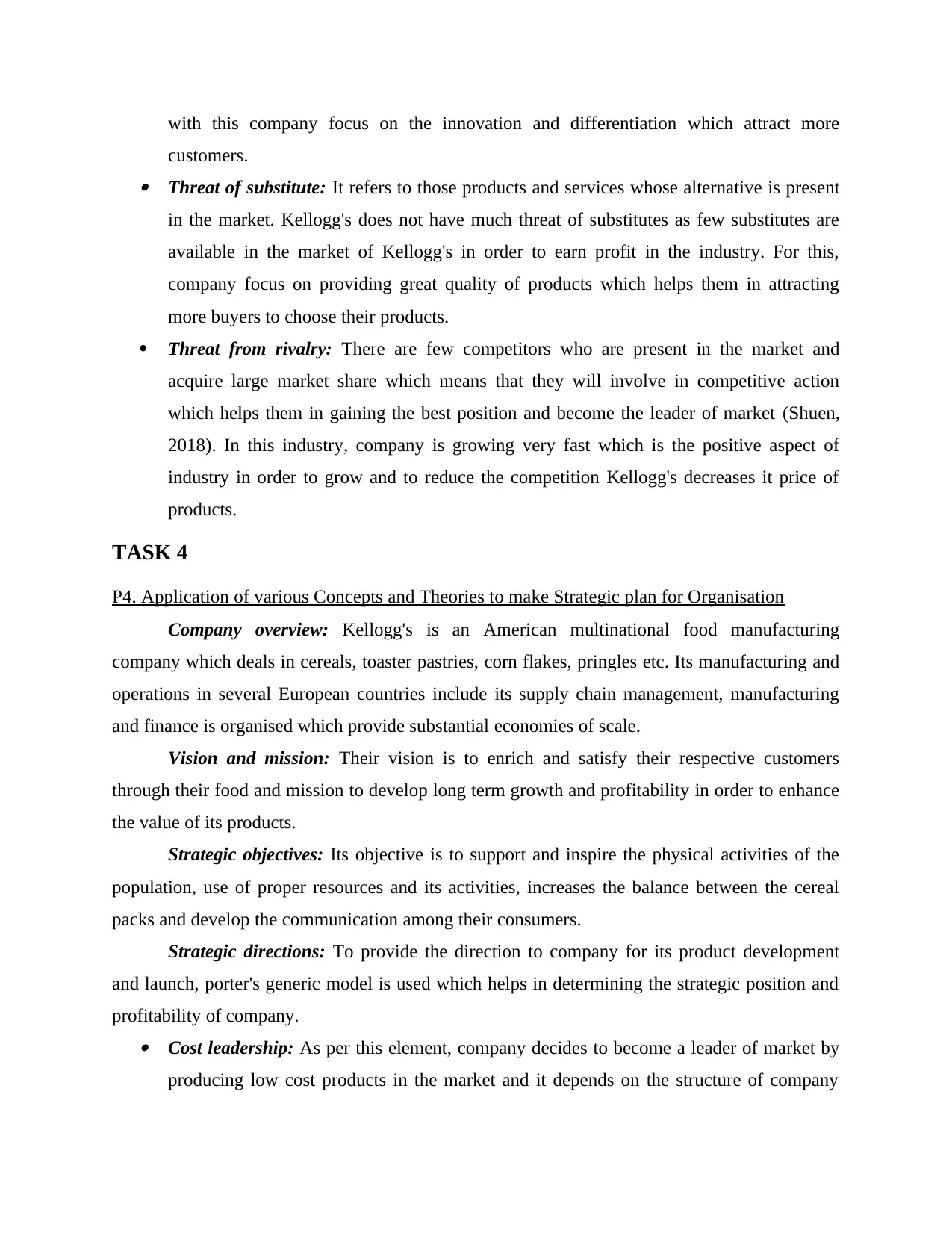
with this company focus on the innovation and differentiation which attract more
customers. Threat of substitute: It refers to those products and services whose alternative is present
in the market. Kellogg's does not have much threat of substitutes as few substitutes are
available in the market of Kellogg's in order to earn profit in the industry. For this,
company focus on providing great quality of products which helps them in attracting
more buyers to choose their products.
Threat from rivalry: There are few competitors who are present in the market and
acquire large market share which means that they will involve in competitive action
which helps them in gaining the best position and become the leader of market (Shuen,
2018). In this industry, company is growing very fast which is the positive aspect of
industry in order to grow and to reduce the competition Kellogg's decreases it price of
products.
TASK 4
P4. Application of various Concepts and Theories to make Strategic plan for Organisation
Company overview: Kellogg's is an American multinational food manufacturing
company which deals in cereals, toaster pastries, corn flakes, pringles etc. Its manufacturing and
operations in several European countries include its supply chain management, manufacturing
and finance is organised which provide substantial economies of scale.
Vision and mission: Their vision is to enrich and satisfy their respective customers
through their food and mission to develop long term growth and profitability in order to enhance
the value of its products.
Strategic objectives: Its objective is to support and inspire the physical activities of the
population, use of proper resources and its activities, increases the balance between the cereal
packs and develop the communication among their consumers.
Strategic directions: To provide the direction to company for its product development
and launch, porter's generic model is used which helps in determining the strategic position and
profitability of company. Cost leadership: As per this element, company decides to become a leader of market by
producing low cost products in the market and it depends on the structure of company
customers. Threat of substitute: It refers to those products and services whose alternative is present
in the market. Kellogg's does not have much threat of substitutes as few substitutes are
available in the market of Kellogg's in order to earn profit in the industry. For this,
company focus on providing great quality of products which helps them in attracting
more buyers to choose their products.
Threat from rivalry: There are few competitors who are present in the market and
acquire large market share which means that they will involve in competitive action
which helps them in gaining the best position and become the leader of market (Shuen,
2018). In this industry, company is growing very fast which is the positive aspect of
industry in order to grow and to reduce the competition Kellogg's decreases it price of
products.
TASK 4
P4. Application of various Concepts and Theories to make Strategic plan for Organisation
Company overview: Kellogg's is an American multinational food manufacturing
company which deals in cereals, toaster pastries, corn flakes, pringles etc. Its manufacturing and
operations in several European countries include its supply chain management, manufacturing
and finance is organised which provide substantial economies of scale.
Vision and mission: Their vision is to enrich and satisfy their respective customers
through their food and mission to develop long term growth and profitability in order to enhance
the value of its products.
Strategic objectives: Its objective is to support and inspire the physical activities of the
population, use of proper resources and its activities, increases the balance between the cereal
packs and develop the communication among their consumers.
Strategic directions: To provide the direction to company for its product development
and launch, porter's generic model is used which helps in determining the strategic position and
profitability of company. Cost leadership: As per this element, company decides to become a leader of market by
producing low cost products in the market and it depends on the structure of company
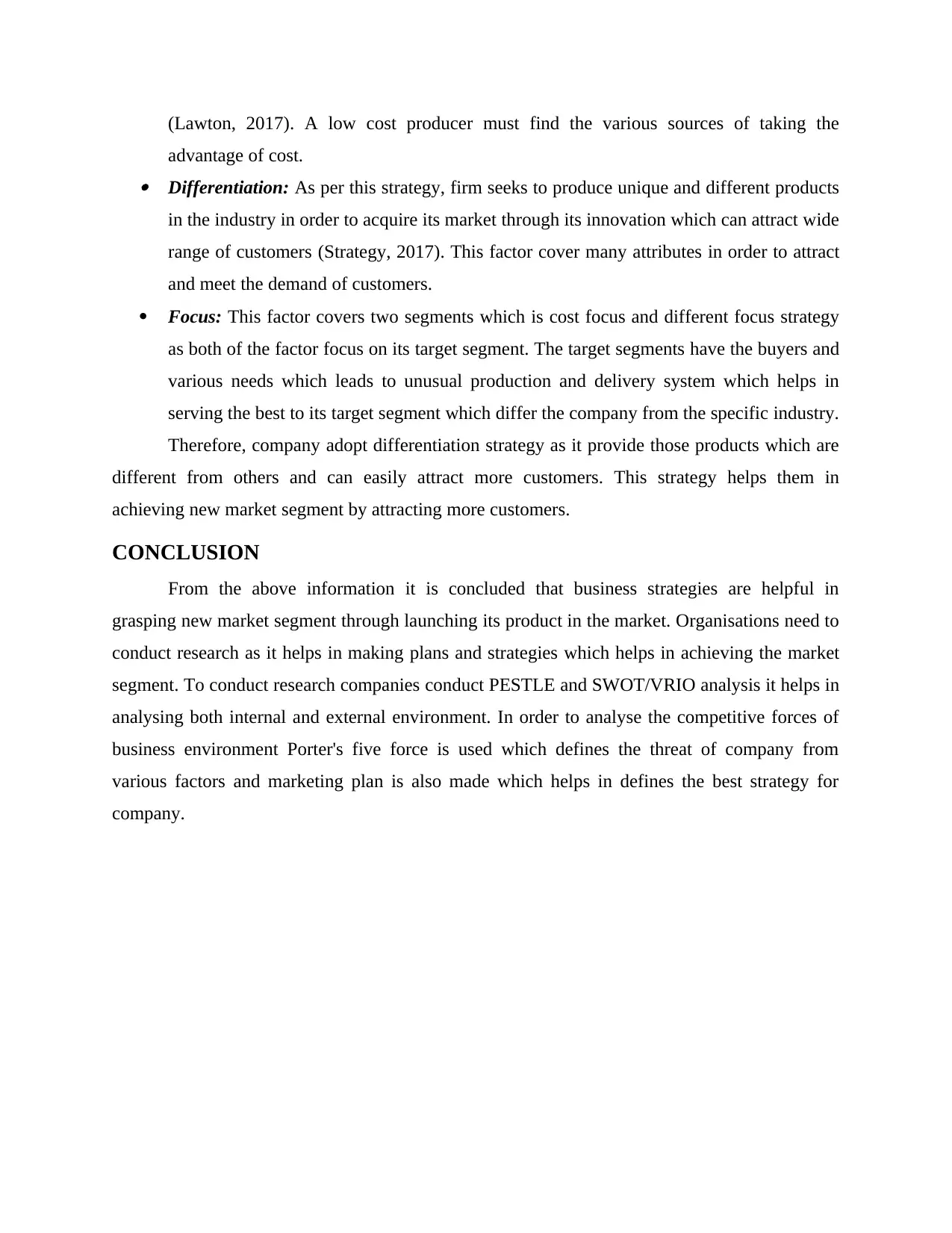
(Lawton, 2017). A low cost producer must find the various sources of taking the
advantage of cost. Differentiation: As per this strategy, firm seeks to produce unique and different products
in the industry in order to acquire its market through its innovation which can attract wide
range of customers (Strategy, 2017). This factor cover many attributes in order to attract
and meet the demand of customers.
Focus: This factor covers two segments which is cost focus and different focus strategy
as both of the factor focus on its target segment. The target segments have the buyers and
various needs which leads to unusual production and delivery system which helps in
serving the best to its target segment which differ the company from the specific industry.
Therefore, company adopt differentiation strategy as it provide those products which are
different from others and can easily attract more customers. This strategy helps them in
achieving new market segment by attracting more customers.
CONCLUSION
From the above information it is concluded that business strategies are helpful in
grasping new market segment through launching its product in the market. Organisations need to
conduct research as it helps in making plans and strategies which helps in achieving the market
segment. To conduct research companies conduct PESTLE and SWOT/VRIO analysis it helps in
analysing both internal and external environment. In order to analyse the competitive forces of
business environment Porter's five force is used which defines the threat of company from
various factors and marketing plan is also made which helps in defines the best strategy for
company.
advantage of cost. Differentiation: As per this strategy, firm seeks to produce unique and different products
in the industry in order to acquire its market through its innovation which can attract wide
range of customers (Strategy, 2017). This factor cover many attributes in order to attract
and meet the demand of customers.
Focus: This factor covers two segments which is cost focus and different focus strategy
as both of the factor focus on its target segment. The target segments have the buyers and
various needs which leads to unusual production and delivery system which helps in
serving the best to its target segment which differ the company from the specific industry.
Therefore, company adopt differentiation strategy as it provide those products which are
different from others and can easily attract more customers. This strategy helps them in
achieving new market segment by attracting more customers.
CONCLUSION
From the above information it is concluded that business strategies are helpful in
grasping new market segment through launching its product in the market. Organisations need to
conduct research as it helps in making plans and strategies which helps in achieving the market
segment. To conduct research companies conduct PESTLE and SWOT/VRIO analysis it helps in
analysing both internal and external environment. In order to analyse the competitive forces of
business environment Porter's five force is used which defines the threat of company from
various factors and marketing plan is also made which helps in defines the best strategy for
company.
⊘ This is a preview!⊘
Do you want full access?
Subscribe today to unlock all pages.

Trusted by 1+ million students worldwide
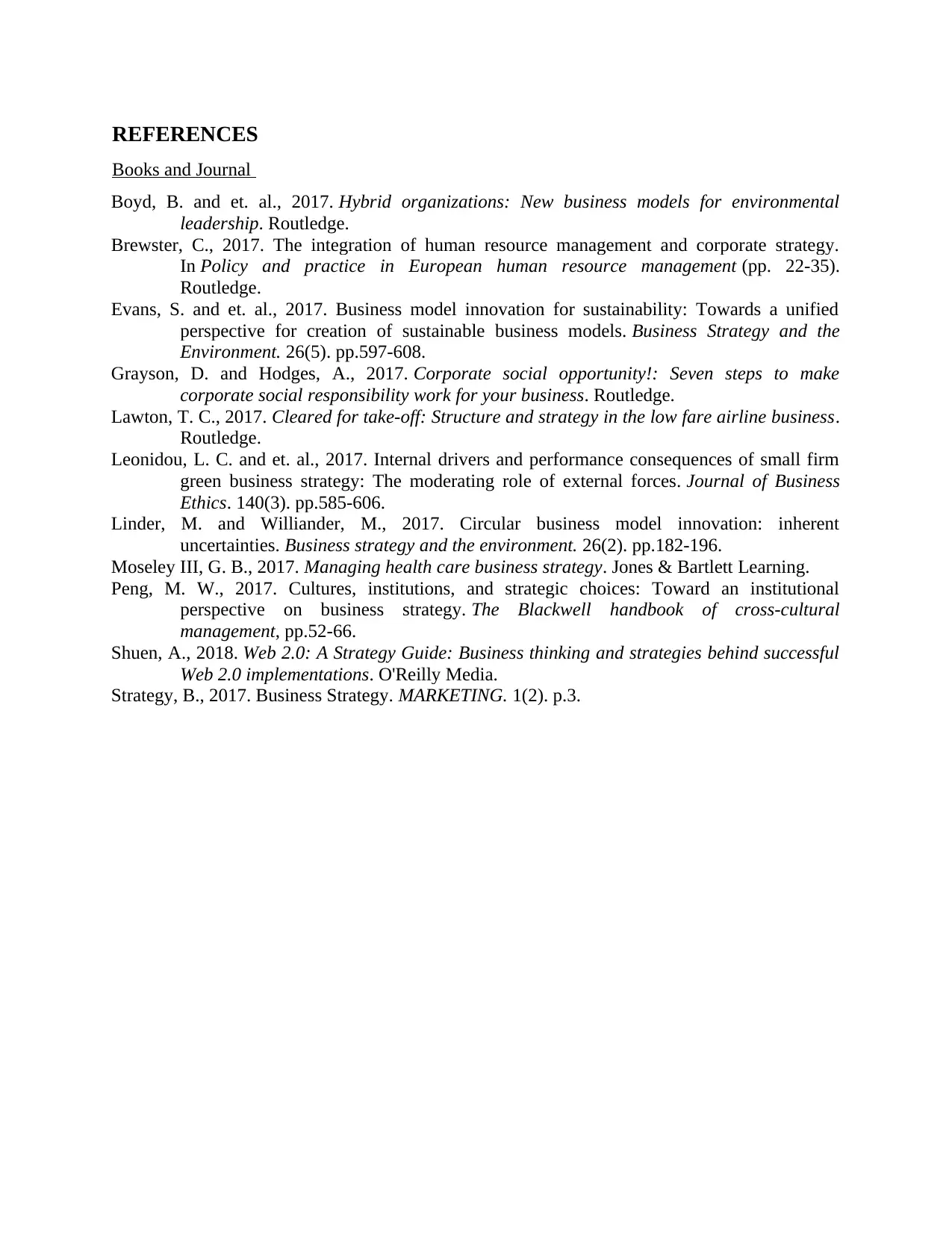
REFERENCES
Books and Journal
Boyd, B. and et. al., 2017. Hybrid organizations: New business models for environmental
leadership. Routledge.
Brewster, C., 2017. The integration of human resource management and corporate strategy.
In Policy and practice in European human resource management (pp. 22-35).
Routledge.
Evans, S. and et. al., 2017. Business model innovation for sustainability: Towards a unified
perspective for creation of sustainable business models. Business Strategy and the
Environment. 26(5). pp.597-608.
Grayson, D. and Hodges, A., 2017. Corporate social opportunity!: Seven steps to make
corporate social responsibility work for your business. Routledge.
Lawton, T. C., 2017. Cleared for take-off: Structure and strategy in the low fare airline business.
Routledge.
Leonidou, L. C. and et. al., 2017. Internal drivers and performance consequences of small firm
green business strategy: The moderating role of external forces. Journal of Business
Ethics. 140(3). pp.585-606.
Linder, M. and Williander, M., 2017. Circular business model innovation: inherent
uncertainties. Business strategy and the environment. 26(2). pp.182-196.
Moseley III, G. B., 2017. Managing health care business strategy. Jones & Bartlett Learning.
Peng, M. W., 2017. Cultures, institutions, and strategic choices: Toward an institutional
perspective on business strategy. The Blackwell handbook of cross‐cultural
management, pp.52-66.
Shuen, A., 2018. Web 2.0: A Strategy Guide: Business thinking and strategies behind successful
Web 2.0 implementations. O'Reilly Media.
Strategy, B., 2017. Business Strategy. MARKETING. 1(2). p.3.
Books and Journal
Boyd, B. and et. al., 2017. Hybrid organizations: New business models for environmental
leadership. Routledge.
Brewster, C., 2017. The integration of human resource management and corporate strategy.
In Policy and practice in European human resource management (pp. 22-35).
Routledge.
Evans, S. and et. al., 2017. Business model innovation for sustainability: Towards a unified
perspective for creation of sustainable business models. Business Strategy and the
Environment. 26(5). pp.597-608.
Grayson, D. and Hodges, A., 2017. Corporate social opportunity!: Seven steps to make
corporate social responsibility work for your business. Routledge.
Lawton, T. C., 2017. Cleared for take-off: Structure and strategy in the low fare airline business.
Routledge.
Leonidou, L. C. and et. al., 2017. Internal drivers and performance consequences of small firm
green business strategy: The moderating role of external forces. Journal of Business
Ethics. 140(3). pp.585-606.
Linder, M. and Williander, M., 2017. Circular business model innovation: inherent
uncertainties. Business strategy and the environment. 26(2). pp.182-196.
Moseley III, G. B., 2017. Managing health care business strategy. Jones & Bartlett Learning.
Peng, M. W., 2017. Cultures, institutions, and strategic choices: Toward an institutional
perspective on business strategy. The Blackwell handbook of cross‐cultural
management, pp.52-66.
Shuen, A., 2018. Web 2.0: A Strategy Guide: Business thinking and strategies behind successful
Web 2.0 implementations. O'Reilly Media.
Strategy, B., 2017. Business Strategy. MARKETING. 1(2). p.3.
1 out of 10
Related Documents
Your All-in-One AI-Powered Toolkit for Academic Success.
+13062052269
info@desklib.com
Available 24*7 on WhatsApp / Email
![[object Object]](/_next/static/media/star-bottom.7253800d.svg)
Unlock your academic potential
Copyright © 2020–2025 A2Z Services. All Rights Reserved. Developed and managed by ZUCOL.





